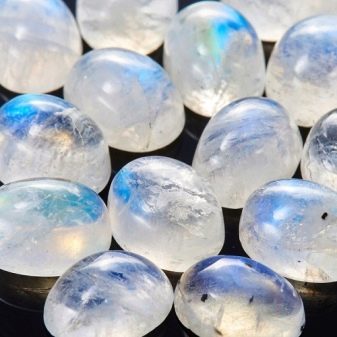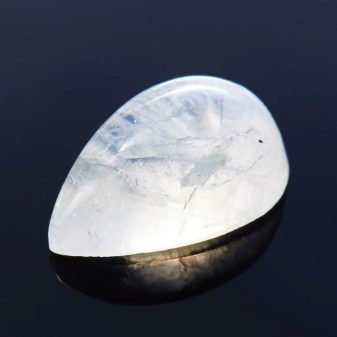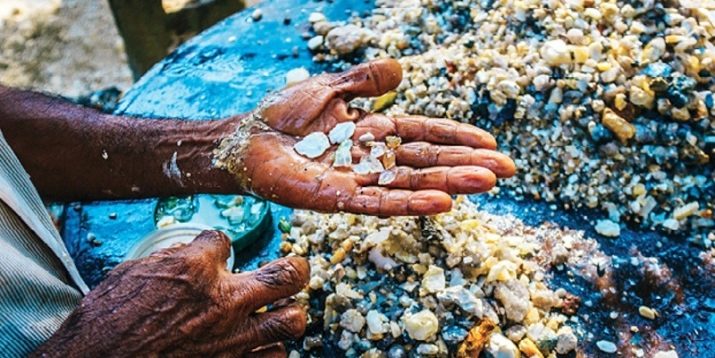How to distinguish natural moonstone?

The moonstone, or as it is otherwise called by the encyclopedias - adularia, attracts with magical and healing power, as well as beauty. Before buying this mineral, many are concerned about how to distinguish natural moonstone from a fake.


Natural mineral appearance
On the gem, as a rule, there is no pattern, it is colorless or light gray with a pronounced milky, lilac or blue tint, for which it is called lunar. However, there are also unique specimens with a pattern in the form of stars, with the effect of "cat's eye", or pale yellow.
Features of the stone:
- has a pearlescent luster;
- getting into a room with artificial lighting, it begins to flicker with light from the inside;
- if you direct a magnifying glass at it, then small cracks, inclusions, an inhomogeneous structure in the form of plates and air bubbles will open to the eye;
- the moonstone is fragile or has an average degree of hardness - 6-6.5 points on the Mohs scale.


Gem properties
Natural moonstone is believed to have magical and healing properties.
Magical
Many peoples consider the moonstone sacred and value it above gold. Magicians use the mineral to look into the future. In addition, the gem makes it possible to find harmony with nature and the surrounding world, fights stress and depression, resolves conflicts, makes a person more merciful, tolerant and fills with love.
It is often chosen as a decoration and is worn on the right hand by people born under the signs of the element of Water: Cancer, Scorpio, Pisces. For emotional and creative individuals, he is the best talisman.The use of a mineral during meditation can activate creativity, awaken imagination.
Magic rites, as usual, are performed on the full moon, when the stone is saturated with tremendous power.


There are hundreds of legends about the moonstone. For example, people believe that a white speck appears on it, which grows in size as the moon grows. At this time, the stone is very cold and sparkles especially brightly, radiating a powerful power of magic. As the time approaches the full moon, the intensity of the mineral's radiance decreases. In the old days, it was believed that originally there is a moonstone in any mineral, but not all of them turn into jewelry.
For transformation, it is required that the gem lies in the same place for a long time, absorbing the light of a large number of full moons. Thanks to this procedure, it begins to shine like the moon, in addition, under the influence of light, its surface is leveled and becomes smooth, like a pebble. A person who has found such a stone gains the ability to predict the future.
There is a belief that the moonstone is an irreplaceable assistant in a difficult situation, it guides you to the right decision. To do this, you need to wait until the moon rises, and hold a pebble under it in your hands. The necessary thought will come to mind itself.


Healing
Moonstone has a great healing effect. It has been used to treat liver diseases, kidney problems, epilepsy, and sleepwalking for hundreds of years. The gem has a beneficial effect on the genitourinary system, heart, pituitary gland, intestines, facilitates childbirth and cleanses the lymph. In Europe during the Middle Ages, they were sure that the mineral, "shedding tears" on a moonlit night, leaves moisture that cures fever.
In addition, the moonstone is a good helper for a woman in losing weight, as well as in the fight against cancerous tumors, inflammation and edema.


Reasons and types of fakes
The moonstone has often been counterfeited lately. This happens for a number of reasons:
- depletion of mineral reserves;
- considerable physical and financial investments in the extraction of a gem;
- high price of adularia;
- difficulties in processing moonstone, lack of professionals;
- huge demand for jewelry made of mineral.

The raw materials and technologies for the production of fakes are different. There are several types of imitations.
- Simulated synthesized stone... Made of plastic or opaque glass. The material is pre-coated with paint that repeats the natural color of the gem.
- Belomorite. This natural stone looks like an adularia. His deposit is located in the White Sea region.
- Peristerite or albite. A kind of mineral from the silicate category.
- Ornaments made of pressed crumbs of moonstone. It happens that it is replaced with olikoglazovy crumb, using silicate minerals of low quality.
A large number of fakes are brought from India, and more often than not, no one there tries to hide that the moonstone is artificial. Therefore, such goods (mainly jewelry) began to be attributed to a separate category of products.


How to distinguish the original?
It is important to diminish the distinction of natural moonstone.
From counterfeiting
It is often not only a specialist, but also a layman, who can determine the authenticity. There are a number of ways to do this.
- Dip in water... The color of a real pebble becomes much more saturated, and the glow from the inside is distinguished by additional highlights, which you will not see in a fake. A fake mineral, unlike a natural one, will retain its original appearance, it can only become cleaner.
- Observe thermal conductivity. The artificial gem, squeezed in the hand, immediately becomes warm, but the original will still be cold. It takes a long time to heat a natural stone.
- Consider the color. It is realistic to identify a fake in terms of gamut and color saturation. Since the structure of the mineral is not uniform, the color will also be uneven.An artificially grown mineral is visible to the naked eye by an overly bright color.
- Check the ability to reflect light. Artificial gems reflect light evenly from all sides, genuine only at an angle of 10-15 degrees.
- Assess surface smoothness... When you touch the natural adularia, you feel silkiness.
- Natural mineral is often framed with silver, and fake stones - alloys of cheap metals.
- Pay attention to the cost... A real moonstone, as opposed to a fake one, is expensive. The price of adularia in a silver frame is at least 5-7 thousand rubles.


From imitations
This task is much more difficult, since they are very similar, and requires the intervention of an expert, laboratory research.
There are several signs that help distinguish moonstone from belomorite.
- Density. For a moonstone, it is 2.56-2.62, which is slightly lower than the indicator of belomorite.
- Coloring. The tone of the natural gem is less bright.
- Transparency. A lunar stone is more transparent than white mite.
A better imitation of moonstone - peristerite. When comparing minerals, jewelers point to several distinguishing features:
- moonstone is more fragile than peristerite;
- the density of the adularia is slightly lower than that of its imitation;
- the index of refraction of light of the moonstone is lower than that of peristerite;
- different ability to split - adularia has monoclinic, its imitation is perfect.


Expert advice
Before buying a stone, follow these simple tips.
- Natural adularia cannot be found in a jewelry store, so you have to go to a special salon. They are required to provide information about where the gem was mined, show a quality certificate, and a professional jeweler will determine the authenticity of the mineral.
- The stone should be purchased only from a reliable seller.
For the amazing properties of moonstone, see the next video.








